Also - See photos and comments from the 2005, 2006, 2007,2008 CES & ICCE
Showest 2008,
2009 CTIA
2009 |
| Get on our distribution list - click here |
| Read a free report on the Top 10 Trends at CES 2009 |
|
|
|
|
| CES Pre-Show Highlights (Jan 6) - Scroll Down to See Everything |
|
|
2009 is the "year of astronomy" as it was 400 years ago that
Galileo first used a telescope to unravel the mysteries of
the night sky. Meade Instruments is marking the occasion by
introducing a product that takes the mystery out of
operating a telescope. The new ETX-LS improves on previous
automated telescopes by adding a camera that automatically
"sees" target stars for alignment, making setup as simple as
turning on a switch. The 6" aperture Advanced Coma-Free
scope also includes over four hours of audio and video (for
external monitor) to describe what you're looking at.
$1299. |
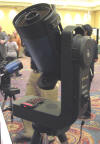 |
These bluetooth sunglasses have built-in ear buds and microphone. You can listen to music and talk on your phone without looking like you have growth on your ear.
Tri-Spec will be selling them for about $199. They are looking for a retailer to carry their line. |  | If you like to know where all of the traffic-cameras are, the new Cobra radar detectors are just the ticket. The latest models come with their Aura service which downloads up-to-date location information to a USB card that you can plug into the side of their detectors. They even tell you when you're passing a camera and which side of the road it's on. |  |
 | This product is called the Pacemaker. It is not for your heart, but is a portable interface that lets you be a DJ at a party. You can fade one song into another, match their beat, and adjust several other parameters. It has 60 GB to hold songs and will be sold for about $550 starting in April. |  | If you want to use a Bluetooth earpiece, but want to look stylish, LG has a jewel-encrusted one that women might like. Expect more of these fashion-oriented personal products in the future. This one is the model HBM-530 (not a sexy name) and will be out in February (price unknown) |
| Novint showed an earlier version of this before. The novel "mouse" moves within a 4"x4"x4" cube space. The unit shown has a pistol grip attached. Rotation and Pitch not yet available. Also provides haptic feedback. About 50 games work with this interface, with more to come. $199. |  | Kablamm makes this Mech RC robot for teaching kids and general fun. You can program and control it via a remote or PC. Sells for about $600. |  |
| CES Pre-Show Highlights (Jan 7) |
| | | | |
|
| LG gave a sneak peak at their watch phone with MP3, etc. The model in the photograph didn't seem like a full working one. The photo to the right is probably a mock-up of one of the screens.
In general, LG put on a good show of new technologies. Of note is a phone with two microphones that made it possible to cut out ambient noise, much like the noise canceling headsets do - only the person you are talking to gets the benefit because your noisy environment is cut out. |  | 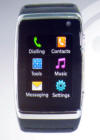 |
 |  | The ATSC made a decision last year and picked LG's version of a mobile TV system over Samsung's. The photo to the left shows a working phone with TV (9 stations in Las Vegas currently broadcast in this mobile format). The other photo shows the schedule. |
Netgear showed a pair of Internet Video streaming products designed to show the results on your TV. The unit on the left (being held) is a small box that simply streams content. This is called the ITV-2000 and uses the VuNow interface. The unit to the right is the Digital Entertainer Elite and it handles HDTV and has 500GB of storage. Storage is upgradeable (see open door) and can also link to a NAS with 6 hard-drive bays (see unit to far left in photo).
The question of how long these stand-alone products will last is one you should be asking yourself. It is too easy to build these features into the Blu-ray player or TV, as some have begun to do aready. | 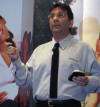 |  |
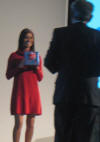 |  | Casio showed two differentiating technologies. The first, not shown here, is a new line of cameras aimed at consumers that can take full frame (6MP) shots at 30 fps, and lower evel shots at 1,000 fps (yes, one thousand frames per second). This will open up all kinds of fun shots for the ordinary consumer. The technology also lets them combine shots to remove blur when zoomed in or taking shots in low light situations. Very cute.
The photos to the left show their composite video feature. In the first shot the model is captures in video moving the gift box towards the camera. In the second shot you see the model superimposed onto an Internet card, again moving the gift towards you. |
Panasonic's major development is their work on 3D TV. Together with their Hollywood Labs, they've been working on a set of proposed standards. They have, but did not show in this meeting, a 1080p 3D plasma TV. Other 3D TV systems usually give up some resolution to achieve 3D. A number of other companies also talked about 3D this year.
The photo to the right is Panasonic's thin LCD TV is shown to the right. "Thin" was another theme by some. This TV is 1/3 inch thick! | 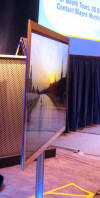 | Panasonic also briefly showed a portable Blu-ray player/display. Such products are common for standard DVD, but now we see one for Blu-ray. |  |
 | Toshiba, among others, talked about their TV Widgets. In this case, it is based on Yahoo's Widgets, first shown at Intel's IDF last year. Almost every TV mfr has widget features now - many are proprietary, some are based on Yahoo. Expect to see Google in this space. |  | Sharp did the smart thing by focusing just on LCD. The slide to the left shows their tenth generation LCD panel, measuring 112"x120". TV mfrs. did not try to race each other on size this year (the first time in a great while). Partly you can blame the economy. |
| Samsung showed a sleek Blu-ray player that was thin (1.5 inch) and wall-mountable. It is the model BD-P4600, and it is out in the second quarter. Price unknown. |  | Any company that made a camcorder now is showing off their flash-based HD camcorder this time. The one shown on the right is from Samsung and it has 64GB of flash (12 hours). SSD HMX-H106. |  |
| Samsung is showing off their LED backlit LCD TV with the ability to adjust the backlight according to parts of the scene. In general, LED backlit LCD TVs were shown by everyone, along with at least 120 Hz, and usually 240 Hz scanning for better motion display. |  | While we don't have a photo of Panasonic's 3D TV, here is one from Sony's 3D TV. It uses the Real-D (circular polarized) glasses that are used in most 3D theaters. If you want to learn more about 3D movies, see our report on Digital Cinema. |  |
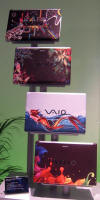 | Sony also showed off a line of stylish notebook PCs. Now that PCs have generally matured, features such as looks become a bigger factor. |  | Sony is also taking advantage of the fact that they own Jeopardy. They set up a Jeopardy stage in their booth from which the actual show will be broadcast during CES. |
| Wowee always shows creative products with a twist on things. The SpyBall rolls around under the control of your portable game (e.g. Sony PSP). The video is seen on your game's display. This will be available in the Fall for about $150. |  | iRobot, the maker of the auto vacuum cleaner, has come out with an improved gutter cleaner. The wireless control moves the cleaner forward and back. The product is called a Looj, and it flips the leaves (even wet ones) out with a spinning set of flaps. Available in the Sprint for $129. |  |
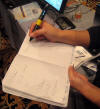 | 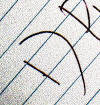 | Livescribe has a very interesting product called a Smartpen. You write notes on special paper. As you write, the pen records audio. Later, when you are reviewing your notes, you can instantly hear what was said at the time you wrote those notes by tapping the pen at the section of notes you are reading. It uses special paper with tiny dots on it (see second photo) which comes in special note pads; or, you can now print your own paper using your printer.
The pen can also act as a calculator by tapping a number pad. And, it can translate words into other languages.
A 1GB version costs $149 while a 2GB version is $199. |
| The laser-lit TV from Mitsubishi is finally available. Using a laser result in one-fifth the power draw and a wider color gamut. It uses a single DLP. Looks good. Unfortunately, it also costs about $7000 for this 65" TV, and rear projection is fading in popularity as panel TVs get more affordable. |  | Lynksys showed off a set of products for wireless whole home audio. The units shown show a handheld controller and speaker units. | 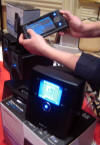 |
 | Clickfree Transformer turns any USB hard disk drive into a one-click backup storage device. | 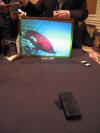  | 3M pocket-sized projectors roughly the size of two decks of cards project images the size of a large notebook screen.
The 2nd photo shows the imaging engine inside the projector. |
| CES - Day One (Jan 8) - click photos to enlarge |
A concept technology that Panasonic was showing in their booth promises to be an industry-changing concept. It is a remote control that consists of two touchpads, similar to the one found on a notebook PC. You can use it one or two-handed. The photo to the left shows a one-handed operation. You get visual feedback on the TV screen so you don't have to look down at the remote. Look closely and you will see a picture of a thumb on the screen. This arrangement affords a wide amount of flexibility in the user interface - and it removes the limitations of the arrow keys used by almost all remote controls.
The photo to the right shows a two-handed operation where the demo lets a person thumb-type on a QWERTY keyboard displayed on the screen. |  |  |
 | Tom Hanks is wearing pair of concept 3D glasses from Sony. The glasses put the image on a clear glass so the wearer can still see around them. |  | Golla got into PC cases a few years ago with some very stylish designs. Style has become a key element in many other companies' line of late, but Golla has the widest and nicest line of products (with a European angle, since they come from Finland). The model shown is their new "Black" line, selling for a slight premium over their standard line. The PC case shown sells for about $45. |
| Shapeways offers the world's first consumer 3D modeling service. The technique is used by mechanical engineers and designers - a machine "prints" a 3D model directly from the computer. Now you, the consumer, can do the same. They have some simple online design tools or you can use a traditional 3D software design software. For $20 to $80 you get your personalized item delivered to your door. | 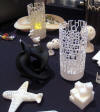 | Schlage is a traditional name for locks, and now they offer a wireless door lock. This was first shown at CEDIA late last year. You can send the lock a special temporary code from your phone. You then can tell someone what the code is and they can open the lock. Handy if a relative shows up unexpectedly while you are at work, etc. The system costs $299. They claim that they paid close attention to preventing hackers from getting in. | 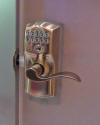 |
 | Brother makes inkjet printers using thermal inkjet technology. This $20K printer prints directly onto T-shirts. Much better color than your home printer using thermal transfers. Costs about $2 to make one shirt.
Their new model 781 adds the ability to print a while layer, so you can print full color on a colored material. $45K. |  | Lots of photo frames all over the place. Some are beginning to see what they can do if they are connected to the Internet. This unit from HP is still in design phase, so many functions did not work. You can get an idea of what it can do from the screen. Sony and others have their version of an enhanced photo frame. |
| CES - Day Two (Jan 9) - click photos to enlarge |
| The chair that looks like a space alien eating the gamer is from Paleo. It is a static chair (see tomorrow's photos for one that is not). Each "workstation chair", as the company calls it, is custom made. This is their third unit. Available soon for $40,000 each. | 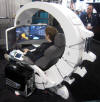 | Of course, we must show the obligatory screenshot of Windows 7. This shot features the multitouch interface that lets you "throw" objects about the screen, much like their tabletop interface shown last year.
Everyone is getting into touch and multitouch. A number of vendors, from HP to Wacom and those you've not heard of showed panels. These panels used proprietary software for the touch interface, but almost all were anticipating porting Windows 7 to their product. |  |
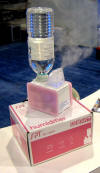 | Sunpentown shows a cute $60 humidifier. You stick your water bottle into the top and turn it on. Great for when you have a really bad flu, take a lot of meds, go to work and plug in your humidifier. |  | Samsung, among others, had demonstrations of how LED backlighting can enhance contrast ratio. The trick was shown years ago by Philips, but they used florescent lights. Dark areas of the scene get a reduced level of backlighting so that the LCD can be modulated with a higher level of contrast. The trick, among others, is how you handle the different areas of the display and how many LED segments you have. Note that early LED LCD displays put the LEDs on the sides, so they could not do this trick as well. |
| With everyone showing off how flat and pretty their panel TVs are, one sometimes hits the wall of disappointment when it comes to connecting the TV to power and the STB and Blu-ray player. Wireless HD and other wireless approaches are starting to address the HDMI connector issue, but you still need to get power to the TV. In comes Flatwire with a very thin 120VAC flat wire. You glue it to the wall and cover it over with drywall spackle, add paint and like magic - "no wires" - and without taking a crowbar to the existing drywall. A 10 length will be about $250, but this includes the unit that protects you and your house from accidents. The 2nd photo gives some clues. There are actually 5 layers - ground, hot, ground, return, ground. If you accidently drive a nail through this cable, you short out the circuit and trip the safety. They are currently going though UL approval, but already are written in the 2008 National Electric Code. | 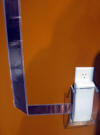 |  |
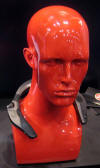 | NxSET is showing their Music 1 "headset". Actually, you might call it a "neckset" because you wear it around your neck. Speakers on either end play your music from your Bluetooth device. There is also a microphone for phone calls. Don't want everyone else to hear your call? No problem - a pair of earbuds can be pulled out for privacy. $159 for people that want a conversation piece. |
| CES - Day Three (Jan 10) |
A long time ago, HP introduced a small hand scanner that one could move around a page. The scanner then stitched the images together to reconstruct the complete page image. The project was internally called Zorro because of the motion one used across the page. The scanner worked by looking very closely at the grain of the paper to determine where the scanner was at it moved. This same sensor later became the key to the optical mouse you probably have in your hand now.
So now a company called Syscan has built a similar type scanner (they claim it is different that HP's patents) into a mouse. |  |  |
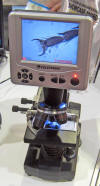 | Celestron makes a series of microscopes for consumers, including this LCD Microscope for $299. |  | Some people like to light up their car with LEDs and show off their big speakers and stereo system that is capable bursting ear drums. Pikaspi has combined these two notions into a line of speakers that light up with the music they are playing. |
| Schwinn now offers this $3200 bike with electric motor assist. They are using battery technology from Toshiba, so the battery charges in 30 minutes. There are three levels of assist (it doesn't move unless you are peddling). | 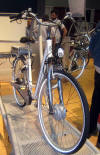 | Avaak makes this very small wireless cam that one can hide in corner of a room. You view the VGA images via a website after entering your password. They give you 2GB of image storage for free. Price has not been set, but it will be out in April. |  |
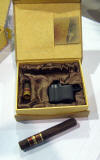 | Everyone in CES was claiming to have a line of "Green" products. This product takes things to a new level, with the world's first Green Electronic Cigar, by Greenworld. For $100 you can puff away and enjoy your cigar without polluting your friends.
On a more serious note, check out the Greenpeace website. They have rated various submitted CE products for their level of "green". This might actually be a valuable service that can help sort out the hype. | Sega Toys, a Japanese company, showed this cute little product called Nodding Leaves. The two leaves wave gently about as they respond to your voice or music. This is available in Japan for about $22 and they hope to sell it in the U.S. soon. |  |
| CES - Day Four (Jan 11) - click on photos to enlarge |
 | I've been following flash memory for some time, and was once loaned several 20 Megabyte cards from SanDisk (when they were called SunDisk) - each card cost $1,000 then. The roadmap to the left shows how things have gone since, though the just introduced SD XC timeline should really say that the 2 Terabyte card will be out in about five years. The XC line is designed for higher capacity up to 2 Terabytes, and faster speeds, up to 300 Megabytes/second. They are using an exFAT disk file system to handle the higher capacities. |
| AT&T and RaySat will be offering a mobile satellite-based TV service this Spring. The service offers over 20 channels, including CNN, Nickelodeon, Cartoon Network, and Disney. The antenna costs about $1299 and service about $28/month. To get around the problem of tall buildings and tunnels, the system buffers up the stream so that programming is generally not interrupted. The downside is that channel changing can be slow. This service is going to be up against a road full of competition that is based on ATSC and phone-based services, so it will be interesting if this goes the way to the satellite phone. |  |
| You probably know about Guitar Hero by now. If so, you know that the guitar controller is very much a toy. The popularity of this game (and its competitor) has prompted Peavey to introduce the Riff Master - a full sized, made-of-wood-body, controller for people that really want to riff. | 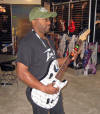 | Valentines is just around the corner and now you can give your loved one half of a matching USB flash drive - Fastar F-PL117. |  |
  | Simcraft has already taken some orders for their APEX SC830, a full motion feedback simulation rig for games like car racing and flying. Their first order was from a bar, so you may actually be able to try this out yourself. Roll (40 degrees), Pitch (25 degrees) and Yawl (40 degrees) provide some real feedback to you if you happen to spin out and hit a wall. Their first model is aimed at driving and sells for $44,000. Their AERO for flight comes out later. They hope to eventually have a 2-axis version for $5,000. |
| The man from U.N.C.L.E. is going to be jealous - UAT is selling their SpyPen PDC030. This $25 pen takes VGA photos, QVGA video while it sits in your shirt pocket. |  | Or, perhaps you are less adventurous and simply want to control your PC via a wireless pen mouse that doubles as a laser pointer. The ISV P&M Pro might be for you. |  |
| Walking through the North Hall of the Las Vegas Convention Center is always a test of one's ears because all the car sound systems are shown, or rather heard there. The speaker offered by MTX shown to the right gives you a visual appreciation. It is the appropriately named Jackhammer. It weighs 369 pounds (a pair will give your car good traction on snow), and handles 3 kilowatts of power. One speaker is about $8,000. You also need a pair of MTX TE4001 amplifiers to drive these speakers - each puts out 4 kilowatts and costs $1,999. Nuclear powered car generator is not included. |  |
| Everyone put a smiling face on the current "economic situation", as the popular phrasing goes. Reading the news, one might think nothing was left of Las Vegas. Gary Shapiro (CEA President) showed a very funny tongue in cheek video in the opening keynote. CEA squeezed booths together and collected empty space behind curtains. There was also an attempt to reduce the riff raff by charging more. Crowds were still large (110K), and the lower attendance was only really visible Sunday morning when you could "shoot a cannon ball down the hall". But by then, the booth duty people were ready to pack up anyway. |     |
ICCE (International Conf. on Consumer Electronics) &
CCNC (Consumer Communications and Networking Conference)
Here you get a sense for what engineers are working on for the next five years and
where the tough problems are for products found on store shelves today.
Many more papers were delivered than are shown here. Go to www.icce.org to learn more.
If you live in Silicon Valley, visit www.ieee.org/scvce to learn about our monthly presentations. |
   | At ICCE Hans Rijns (VP Research for NXP) shared a number of interesting technologies that can enhance the TV. A couple are shown here. The first is a study of LED backlighting for LCD TVs, a popular topic these days. The chart shows a white LED, RGB LED and a Sequential Color approach. Interestingly, the Sequential Color approach shows the lowest power consumption, even though LCD is known for slower switching times.
The other slide shows a way to enlarge images without making the edges look fuzzy, as is typical. Their algorithm looks for edges and duplicates these edges in the enlarged version. |
CCNC is a newer conference (6 years old, whereas ICCE is 27 years old). It, too, is IEEE sponsored (Communications Society).
The concept shown to the right is from AT&T research. It allows a user to set up an automatic search for certain topics in video news feeds. Once captured, the news clip can be shown in full HDTV on your TV, your PC, or your iPhone.
The photo shows the iPhone starting the video on the TV. One idea is to make this a feature for AT&T TV/mobile service customers. |  | Shizuoka University showed a concept at CCNC for a unified remote control system. The demonstration shown at the right uses a Wii controller to move the Cam around. Various translators between the Wii and the networked Cam were used. There were other devices that they were showing, too. |  |
 | There are a few ways that a camera can try to compensate for shake. Many are beginning to use some form of optical stabilization, which can add cost to the camera. Software approaches also exist, but they tend to fall short in quality results. Software usually has a difficult time figuring out just how the camera was moved. The algorithm can also take a long time to compute, and results can still have "ringing artifacts". Sanyo's paper talked about a practical software solution that attacked the problem in three ways. One key trick is to take one main photo and one short reference photo. Information from both are analyzed with about a 200% improvement in movement estimation. This paper by Haruhiko Murata (Sanyo) and Takuya Imaide (Hitachi) won best paper at this year's ICCE. |
| ETRI is South Korea's government funded Electronics and Telecommunications Research Institute. They have a huge staff and many often participate at ICCE. The paper to the right shows a special wrist bracelet that can be used to control consumer electronics through hand gestures. (Hitachi showed a camera-based approach at CES). Something unique about ETRI's approach is that it can pick up the wearer as they tap fingers together. Tapping fingers can be used for channel surfing, for example. Dong-ww Lee, Jeong-mook Lim, John Sunwoo, Bae-sun Kim and Cheo-hoon Lee are the authors. |  |
| |
Read a free report on the Top 10 Trends at CES 2009
| |

